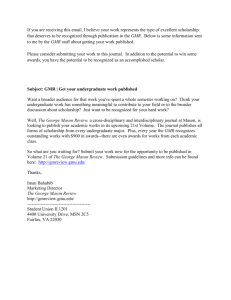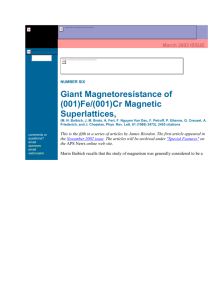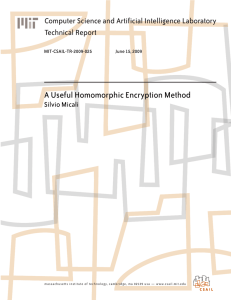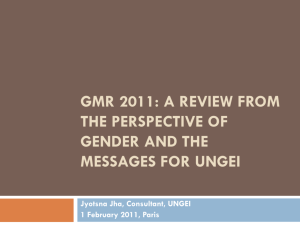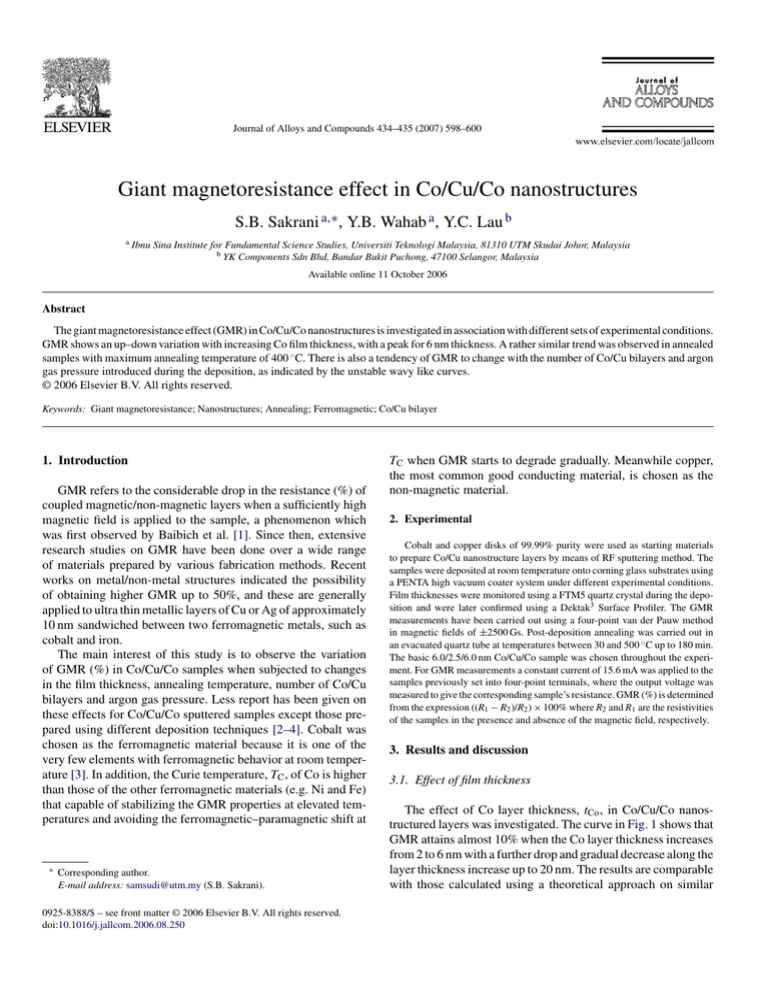
Journal of Alloys and Compounds 434–435 (2007) 598–600
Giant magnetoresistance effect in Co/Cu/Co nanostructures
S.B. Sakrani a,∗ , Y.B. Wahab a , Y.C. Lau b
a
Ibnu Sina Institute for Fundamental Science Studies, Universiti Teknologi Malaysia, 81310 UTM Skudai Johor, Malaysia
b YK Components Sdn Bhd, Bandar Bukit Puchong, 47100 Selangor, Malaysia
Available online 11 October 2006
Abstract
The giant magnetoresistance effect (GMR) in Co/Cu/Co nanostructures is investigated in association with different sets of experimental conditions.
GMR shows an up–down variation with increasing Co film thickness, with a peak for 6 nm thickness. A rather similar trend was observed in annealed
samples with maximum annealing temperature of 400 ◦ C. There is also a tendency of GMR to change with the number of Co/Cu bilayers and argon
gas pressure introduced during the deposition, as indicated by the unstable wavy like curves.
© 2006 Elsevier B.V. All rights reserved.
Keywords: Giant magnetoresistance; Nanostructures; Annealing; Ferromagnetic; Co/Cu bilayer
1. Introduction
GMR refers to the considerable drop in the resistance (%) of
coupled magnetic/non-magnetic layers when a sufficiently high
magnetic field is applied to the sample, a phenomenon which
was first observed by Baibich et al. [1]. Since then, extensive
research studies on GMR have been done over a wide range
of materials prepared by various fabrication methods. Recent
works on metal/non-metal structures indicated the possibility
of obtaining higher GMR up to 50%, and these are generally
applied to ultra thin metallic layers of Cu or Ag of approximately
10 nm sandwiched between two ferromagnetic metals, such as
cobalt and iron.
The main interest of this study is to observe the variation
of GMR (%) in Co/Cu/Co samples when subjected to changes
in the film thickness, annealing temperature, number of Co/Cu
bilayers and argon gas pressure. Less report has been given on
these effects for Co/Cu/Co sputtered samples except those prepared using different deposition techniques [2–4]. Cobalt was
chosen as the ferromagnetic material because it is one of the
very few elements with ferromagnetic behavior at room temperature [3]. In addition, the Curie temperature, TC , of Co is higher
than those of the other ferromagnetic materials (e.g. Ni and Fe)
that capable of stabilizing the GMR properties at elevated temperatures and avoiding the ferromagnetic–paramagnetic shift at
∗
Corresponding author.
E-mail address: samsudi@utm.my (S.B. Sakrani).
0925-8388/$ – see front matter © 2006 Elsevier B.V. All rights reserved.
doi:10.1016/j.jallcom.2006.08.250
TC when GMR starts to degrade gradually. Meanwhile copper,
the most common good conducting material, is chosen as the
non-magnetic material.
2. Experimental
Cobalt and copper disks of 99.99% purity were used as starting materials
to prepare Co/Cu nanostructure layers by means of RF sputtering method. The
samples were deposited at room temperature onto corning glass substrates using
a PENTA high vacuum coater system under different experimental conditions.
Film thicknesses were monitored using a FTM5 quartz crystal during the deposition and were later confirmed using a Dektak3 Surface Profiler. The GMR
measurements have been carried out using a four-point van der Pauw method
in magnetic fields of ±2500 Gs. Post-deposition annealing was carried out in
an evacuated quartz tube at temperatures between 30 and 500 ◦ C up to 180 min.
The basic 6.0/2.5/6.0 nm Co/Cu/Co sample was chosen throughout the experiment. For GMR measurements a constant current of 15.6 mA was applied to the
samples previously set into four-point terminals, where the output voltage was
measured to give the corresponding sample’s resistance. GMR (%) is determined
from the expression ((R1 − R2 )/R2 ) × 100% where R2 and R1 are the resistivities
of the samples in the presence and absence of the magnetic field, respectively.
3. Results and discussion
3.1. Effect of film thickness
The effect of Co layer thickness, tCo , in Co/Cu/Co nanostructured layers was investigated. The curve in Fig. 1 shows that
GMR attains almost 10% when the Co layer thickness increases
from 2 to 6 nm with a further drop and gradual decrease along the
layer thickness increase up to 20 nm. The results are comparable
with those calculated using a theoretical approach on similar
S.B. Sakrani et al. / Journal of Alloys and Compounds 434–435 (2007) 598–600
Fig. 1. GMR% vs. cobalt film thickness.
599
Fig. 3. GMR% vs. number of Co/Cu bilayer for (a) as-prepared and (b) annealed
samples.
Co/Cu/Co samples [3]. This initial change (tCo ≤ 6 nm) is due to
an increase of the amount of ferromagnetic spins in the ferromagnetic layers caused by the ferromagnetic exchange interactions
associated with the increase of ferromagnetic Co layer thickness
[4]. The average dimension of Co particles and magnetic field
efficiency are also increasing as a consequence of increasing tCo.
Further observation at higher thicknesses (tCo > 6 nm) shows a
decrease in GMR due to the decrease in the antiferromagnetic
interactions existing between the two Co layers near the Cu
layer [4]. An increase of Co thickness contributes to a different
saturation state and its resistance, thus, enhancing GMR [3].
during the early state of annealing, and both species become
soluble to each other as they reach 400 ◦ C. In doing so, the Co
atoms gradually precipitate from the Cu matrix and form Co
clusters. When the annealing temperature exceeds 400 ◦ C, Co
particles become larger and result in the appearance of ferromagnetic interactions between larger Co particles. The results
obtained in this study are similar to those predicted using MonteCarlo simulation, where an optimum GMR occurred at around
400 ◦ C [5,6].
3.2. Effect of annealing
The dependence of GMR on the number of bilayers, n, for
samples with (Co/Cu) × n structures was also investigated. The
thicknesses of Co/Cu layers were set at 6.0/2.5 nm and the deposition rate was fixed at 0.06 nm/s. Seven sets of samples, with
n = 3, 5, 7, 8, 9, 10, and 15 have been prepared and tested for
this experiment. In case of non-annealed samples (Fig. 3a) the
GMR increases for n < 5, followed by a further decrease within
the range 5 < n < 9, and another increase up to 12.5% at n = 15.
According to Smadar and Nathan [7], when the magnetic fields
are applied in plane to the sample, the total resistance is not
equal to the sum of resistances of all segments, but it is a rather
increase in resistivity with increasing number of bilayers, i.e.
Rtotal = R1 + R2 + R3 . For annealed samples (400 ◦ C) shown in
Fig. 3b the mode remains unchanged, but it appears to be more
pronounced and shifted upward with GMR exceeding 30%. This
result suggests that GMR can be further improved with a combined number of bilayers and annealing.
The effect of annealing temperatures was studied and the
result is shown in Fig. 2 for the temperature range 200–450 ◦ C
and a fixed duration of 2 h. It seems that GMR increases almost
steadily from 9.8% to 23.7% over the range of 27–400 ◦ C, followed by a rapid falls beyond this point and toward 450 ◦ C. This
can be attributed to the recrystallization of Co and Cu occurred
3.3. Effect of Co/Cu bilayer
3.4. Effect of argon working pressure
Fig. 2. GMR% vs. annealing temperature.
The effect of argon gas pressure introduced during the sputtering process reveals an interesting feature, mainly for the range
between 4.8 and 2.3 mTorr, when the chamber pressure and
deposition rates were fixed at 9 × 10−7 Torr and between 0.03
600
S.B. Sakrani et al. / Journal of Alloys and Compounds 434–435 (2007) 598–600
The Co layer thickness plays a significant role in increasing the
GMR response, but essentially restricted to 6 nm due to changes
in magnetic behaviour. Annealing up to 400 ◦ C was another
key factor for improving GMR. Significant effects of Co/Cu
bilayer and argon pressure were also observed; the former suggested n > 10 whilst the latter recommended an argon pressure
of 2.6 mTorr for optimum GMR%.
Acknowledgement
The authors wish to thank the Government of Malaysia for
providing funds throughout the research.
References
Fig. 4. GMR% vs. argon gas pressure.
and 0.1 nm/s, respectively. The curve in Fig. 4 shows a rapid
increase in GMR from 9.3% to a maximum of 11.4% when the
working pressure is increased from 2.3 to 2.6 mTorr. After this
turning point the curve is observed to decrease rapidly down to
9.6% followed by a further steady drop to 9.2% at 4.8 mTorr.
Following earlier studies on similar samples [5], such a change
in GMR may be attributed to structural changes set by the argon
pressure which responsible for the formation of different grain
sizes of target materials deposited on the substrate. It is possible
that a large amount of Co crystal is formed during the deposition at high argon pressures and creating a very small superparamagnetic grains that may not contributing to GMR due to
magnetization of the sample [8], this causes reduction in GMR.
4. Conclusions
It was observed that the GMR effect in Co/Cu/Co nanostructures was found to be dependent of experimental conditions.
[1] M.N. Baibich, J.M. Broto, A. Fert, F.V.D. Nguyen, F. Petroff, Giant magnetoresistance of (0 0 1)Fe/(0 0 1)Cr magnetic superlattices, Phys. Rev. Lett.
61 (1988) 2472–2475.
[2] M. Hecker, J. Thomas, D. Tietjen, S. Baunack, C.M. Schneider, A. Qiu, N.
Cramer, R.E. Camley, Z. Celinski, Thermally induced modification of GMR
in Co/Cu multilayers: correlation among structural, transport, and magnetic
properties, J. Phys. D: Appl. Phys. 36 (2003) 564–572.
[3] M. Xu, Y. Fan, G. Luo, Z. Mai, Dependence of giant magnetoresistance on
the thickness of magnetic and non-magnetic layers in spin-valve sandwiches,
Phys. Lett. A 272 (2000) 282–288.
[4] A. Yamada, T. Houga, Y. Ueda, Magnetism and magnetoresistance of Co/Cu
multiplayer films produced by pulse control electrodeposition method, J.
Magn. Mag. Mater. 239 (2002) 272–275.
[5] W.D. Wang, F. Zhu, W. Lai, et al., Microstructure, magnetic properties and
giant magnetoresistance of granular Cu–Co alloy, J. Phys. D: Appl. Phys.
15 (1999) 1990–1996.
[6] J.M. Liu, Y. Yang, X.H. Zhou, X.Y. Chen, Z.G. Liu, Magnetic polaran
mechanism of electron transport and magnetoresistance in spin systems: a Monte-Carlo simulation, Mater. Sci. Eng. B 99 (2003) 558–
562.
[7] S. Smadar, W. Nathan, Magnetoresistance of magnetic multilayers: understanding Ohm’s law, J. Phys. A: Struct. Mech. Appl. 302 (1–4) (2001)
382–390.
[8] S. Higashihara, G. Oomi, K. Suenaga, T. Ono, T. Shinjo, Effect of pressure on
the giant magnetoresistance in Fe/Cr multilayers on SrTiO3 (1 0 0) substrate,
Phys. B: Condens. Mat. 57 (2004) 4–16.

